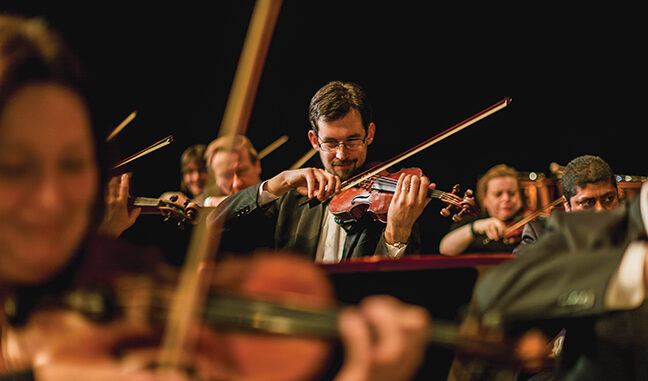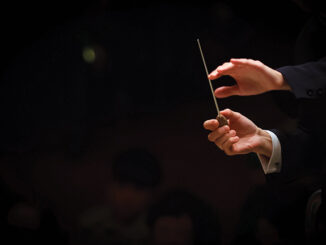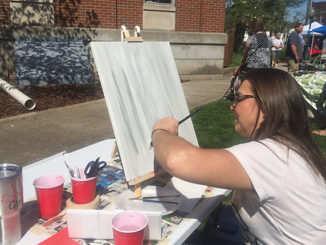
Lyracist Oscar Hammerstein II nailed it when he wrote, “June is bustin’ out all over” for the musical “Carousel.” Salubrious June. Health-giving, beneficial, agreeable, beautiful, select, nice June.
Often June gets hot, like much of the music that Igor Stravinsky and Aram Khachaturian wrote. Both composers were born in June. Some do like their music hot. And June also brings the first official day of the year’s hottest season – Summer.
SUMMER
Summer 2020 in our Northern Hemisphere begins at 4:44pm (CT) Saturday, June 20. The longest day of the year – the June Solstice (Summer Solstice) – occurs when the sun reaches its highest and northernmost point in the sky. “Solstice” comes from the Latin “sol” (sun) and “sistere” (still or stopped). The sun appears to stop moving in the sky as it climbs to the north, and then reverses its course. We know the sun itself is not moving, unless we consider its own orbit around the Milky Way galaxy.
Two composers lived and worked in places known for very late summer sunsets. Edvard Grieg, born June 15, 1843, painted musical images describing the lakes, forested mountains and the crisp atmosphere of his native Norway. Many of his orchestral suites evoke Norway’s country dances and legends, including the Holberg Suite, Norwegian Dances and “Peer Gynt.”
When I was in college, very late at night and winding down before bed, I would often listen to Grieg’s famous (and the only one he wrote) Piano Concerto in A. How soothing it was.
Carl Nielsen, born June 9, 1895 in Denmark, walked the fields of his homeland and wrote tunes like, “The Fog is Lifting.” Much of Nielsen’s work is “early modern”, deep and evocative. His Symphony No. 2, Op. 16, bears the title, “The Four Temperaments.” Each of the four movements of the work explores an aspect of human emotion – “Choleric”, “”Phlegmatic”, Melancholic” and “Sanguine.” Unlike that of his contemporary, the Finn Jean Sibelius, Nielsen’s reputation did not start to evolve until after World War II.
JUNE WEDDINGS?
“June” comes from the Latin “Junius.” Another etymology reveals that June is named after the Roman goddess of marriage. June’s reputation as a preferred month for weddings has an interesting history.
During medieval times a person’s annual bath usually fell in May or June, meaning that June brides smelled relatively fresh. The bride would have smelled more pleasant, but just to be safe, brides carried a bouquet of flowers, to be sure. Hence the custom of carrying a bouquet when walking down the aisle. Others chose June in order to time conception so births wouldn’t interfere with harvest work.
Dozens of composers have immortalized weddings and other pairings in their music. A handful of diverse couples in music spring to mind, like – “Romeo & Juliet,” “Pelleas et Melisande,” “Porgy & Bess,” “Samson & Delilah,” and “Russlan & Ludmilla” – the latter opera by a June musician from Russia. Mikhail Glinka was born June 1, 1804.
One of music’s most notable marriages, and by almost any measurement it stands among the more successful, was that of composer Robert Schumann and Clara Wieck. Schumann, the great German composer of the Romantic Era, gifted pianist and critic, was born June 8, 1810. Schumann left the study of law intending to pursue a career as a virtuoso pianist, but a hand injury ended that dream. He married pianist Clara Wieck after a long and acrimonious legal battle with her father. Stories have it that Grandpa Wieck was eager to see his grandchildren.
Robert and Clara Schumann raised eight children. The couple concertized together and often wrote works dedicated to each other.
LAND OF HOPE AND GLORY
Edward William Elgar came into the world in an English countryside idyll that would color his musical creativity for the rest of his life. Elgar was born on June 2, 1857 near Worchester.
One of his most popular works is also his most mysterious – The Enigma Variations. Each of the 14 variations bears a cryptic subtitle that relates to a particular person or animal, in his life; including his wife, his publisher, various friends and students.
Elgar’s Pomp and Circumstance March No. 1 in D has become known simply as “the graduation song.” How did that happen?
The American tradition started when Elgar was awarded an honorary doctorate in music from Yale University in 1905. The “Trio” from his Pomp and Circumstance March No. 1 was played at the Yale graduation ceremony and was such a hit that years later other schools followed suit; starting with Princeton in 1907, Chicago in 1908 and Columbia in 1913.
The English tradition included the set of lyrics which was never sung in the U.S. In England, the additional words and title, “Land of Hope and Glory,” gave Elgar’s piece the status of a second national anthem.
THE DAY THAT SHOOK THE MUSIC WORLD
Igor Stravinsky, born June 17, 1882, brought about one of the most significant changes in music. Stravinsky’s “The Rite of Spring: Pictures from Pegan Russia in Two Parts” was “dynamite.”
If you know how the music begins, you may not be too surprised by the audience’s reaction to its premiere performance on May 29, 1913. Even today, avant garde musicians listen to “Le Sacre du Printemps” with shock and wonder. Then there’s the theme of the ballet itself – pagan rites culminating with the sacrifice of a young maiden, propitiating the god of spring. The costumes of the dancers were outrageous and the music scandalous.
The tension in the audience between “old” – those preferring the predictable and pretty, and “new” – searching for the bold and uncharted, had reached a boiling point that night in 1913. A musician in the orchestra describes the scene: “Everything available was tossed in our direction, but we continued to play.” Critic Henri Quittard, who apparently sat in the audience, called Stravinsky’s effort “laborious and puerile barbarity.”
Yet, as writer Tom Service observes, no more influential piece of music has been written since that 1913 premiere… Stravinsky himself noted that he was in some kind of super-worldly state while creating “The Rite of Spring,” an echo of the fate of that poor girl who dances herself to death in the ballet’s climactic Sacrificial Dance.
A brief section of “The Rite of Spring” lives on in Walt Disney’s world of animation – “Fantasia” (1940), and “Fantasia 2000” – the latter co-produced by Roy E. Disney. Both films feature narrator Deems Taylor with Leopold Stokowski conducting excerpts from various classical pieces to accompany the colorful artwork and masterful cartoon characters on the screen. It is the awesome, bubbly creation of the earth scene, which is wonderfully energized by Stravinsky’s score.
Given the profound depth and universal impact it continues to have, it seems fitting that “The Rite of Spring” was the featured attraction at the very first concert held in the sparkling new Theatre des Champs-Elysees, Paris. Take a little time to bask in the music of Igor Stravinsky and the other composers born in June.
-by Lee Stott
About the Author: Lee Stott is retired from WKU Public Radio, lives near Franklin with his daughter Cindy Wade’s family and has 30 grandchildren and seven great-grandchildren.







